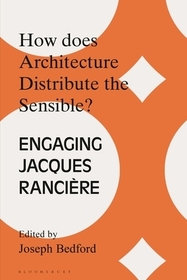
How Does Architecture Distribute the Sensible?
Engaging Jacques Rancière
Series: Architecture Exchange: Engagements with Contemporary Theory and Philosophy;
- Publisher's listprice GBP 85.00
-
40 608 Ft (38 675 Ft + 5% VAT)
The price is estimated because at the time of ordering we do not know what conversion rates will apply to HUF / product currency when the book arrives. In case HUF is weaker, the price increases slightly, in case HUF is stronger, the price goes lower slightly.
- Discount 13% (cc. 5 279 Ft off)
- Discounted price 35 330 Ft (33 647 Ft + 5% VAT)
Subcribe now and take benefit of a favourable price.
Subscribe
40 608 Ft

Availability
Not yet published.
Why don't you give exact delivery time?
Delivery time is estimated on our previous experiences. We give estimations only, because we order from outside Hungary, and the delivery time mainly depends on how quickly the publisher supplies the book. Faster or slower deliveries both happen, but we do our best to supply as quickly as possible.
Product details:
- Publisher Bloomsbury Publishing (UK)
- Date of Publication 11 December 2025
- Number of Volumes Hardback
- ISBN 9781350342804
- Binding Hardback
- No. of pages208 pages
- Size 234x156 mm
- Language English
- Illustrations 20 bw photos 700
Categories
Short description:
Leading architectural theorists exchange ideas with the contemporary philosopher Jacques Ranciï¿1⁄2re in order to debate what architecture's fundamental relationship is with aesthetics.
MoreLong description:
Jacques Ranciï¿1⁄2re is one of the leading thinkers not only of contemporary aesthetic theory but contemporary philosophy in general. After his break from Althusser, Ranciï¿1⁄2re developed the radical and axiomatic principal of the absolute equality of intelligences and capacities that defined his entire body of work, from his critique of philosophy, to his historical studies of emancipated modes of labor and education, to the articulation of dissensus from the order of the police. Ranciï¿1⁄2re's trajectory as a philosopher led him towards aesthetics where offered a radical reinterpretation of the political meaning of aesthetics and with it, of modernism and postmodernism that, having shaken the world of art, is now shaking the world of architecture.
This book brings Jacques Ranciï¿1⁄2re's demand for equality and his reformulation of aesthetics into direct dialogue with architecture. In doing so, it inquires into the role that architecture plays in distributing the sensible, in creating aesthetic experiences, in creating order or dissensus, in serving as a mode of critique, and in emancipating or stultifying its users and subjects.
Through this detailed exchange between Ranciï¿1⁄2re and four of the world's leading architectural thinkers; Anthony Vidler, Joan Ockman, Peggy Deamer and Michael Young, a debate unfolds within the book that tests the implications of Ranciï¿1⁄2re's aesthetic philosophy for architectural practice today; questioning the way we write architectural history, how architects draw, what the labor of the architect is, and that questions key architectural ideas such as the distribution, function, use, ornament, discipline and design.
Table of Contents:
Chapter 1: Introduction: Joseph Bedford (Virginia tech), How does Architecture Distribute the Sensible?
Chapter 2: Peggy Deamer (Yale University), The (Working) Subject of Architecture
Interview: Peggy Deamer
Chapter 3: Anthony Vidler (The Cooper Union), Partage de l'utopie
Interview: Anthony Vidler
Chapter 4: Michael Young (The Cooper Union), The Interruption of the Image
Interview: Michael Young
Chapter 5: Joan Ockman (The University of Pennsylvania), An Apparatus for Emancipated Spectatorship
Interview: Joan Ockman
Chapter 6: Jacques Ranciï¿1⁄2re (Universitï¿1⁄2 de Paris, VIII), Architecture and Aesthetics
Interview: Jacques Ranciï¿1⁄2re
Chapter 8: Discussion
9: Bibliography





